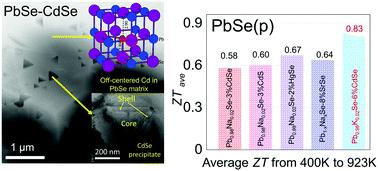当前位置:
X-MOL 学术
›
Energy Environ. Sci.
›
论文详情
Our official English website, www.x-mol.net, welcomes your feedback! (Note: you will need to create a separate account there.)
Discordant nature of Cd in PbSe: off-centering and core–shell nanoscale CdSe precipitates lead to high thermoelectric performance
Energy & Environmental Science ( IF 32.5 ) Pub Date : 2019-11-14 , DOI: 10.1039/c9ee03087e Songting Cai 1, 2, 3, 4 , Shiqiang Hao 1, 2, 3, 4 , Zhong-Zhen Luo 2, 3, 4, 5, 6 , Xiang Li 4, 7, 8, 9 , Ido Hadar 2, 3, 4, 5 , Trevor P. Bailey 4, 10, 11, 12 , Xiaobing Hu 1, 2, 3, 4, 13 , Ctirad Uher 4, 10, 11, 12 , Yan-Yan Hu 4, 7, 8, 9, 14 , Christopher Wolverton 1, 2, 3, 4 , Vinayak P. Dravid 1, 2, 3, 4, 13 , Mercouri G. Kanatzidis 2, 3, 4, 5
Energy & Environmental Science ( IF 32.5 ) Pub Date : 2019-11-14 , DOI: 10.1039/c9ee03087e Songting Cai 1, 2, 3, 4 , Shiqiang Hao 1, 2, 3, 4 , Zhong-Zhen Luo 2, 3, 4, 5, 6 , Xiang Li 4, 7, 8, 9 , Ido Hadar 2, 3, 4, 5 , Trevor P. Bailey 4, 10, 11, 12 , Xiaobing Hu 1, 2, 3, 4, 13 , Ctirad Uher 4, 10, 11, 12 , Yan-Yan Hu 4, 7, 8, 9, 14 , Christopher Wolverton 1, 2, 3, 4 , Vinayak P. Dravid 1, 2, 3, 4, 13 , Mercouri G. Kanatzidis 2, 3, 4, 5
Affiliation

|
We report a novel hierarchical microstructure in the PbSe–CdSe system, which collectively contributes to significant enhancement in thermoelectric performance, with ZTave ∼ 0.83 across the 400–923 K temperature range, the highest reported for p-type, Te-free PbSe systems. We have investigated the local atomic structure as well as the microstructure of a series of PbSe–xCdSe materials, up to x = 10%. We find that the behavior of the Cd atoms in the octahedral rock salt sites is discordant and results in off-center displacement and distortion. Such off-centered Cd in the PbSe matrix creates (1) L–Σ electronic energy band convergence, (2) a flattened L band, both contributing to higher Seebeck coefficients, and (3) enhanced phonon scattering, which leads to lower thermal conductivity. These conclusions are supported by photoemission yield spectroscopy in air (PYSA), solid state 111Cd, 77Se NMR spectroscopy and DFT calculations. Above the solubility limit (>6%CdSe), we also observe endotaxial CdSe nano-precipitates with core–shell architecture formed in PbSe, whose size, distribution and structure gradually change with the Cd content. The nano-precipitates exhibit a zinc blende crystal structure and a tetrahedral shape with significant local strain, but are covered with a thin wurtzite layer along the precipitate/matrix interface, creating a core–shell structure embedded in PbSe. This newly discovered architecture causes a further reduction in lattice thermal conductivity. Moreover, potassium is found to be an effective p-type dopant in the PbSe–CdSe system, leading to an enhanced power factor, a maximum ZT of ∼1.4 at 923 K for Pb0.98K0.02Se–6%CdSe.
中文翻译:

Cd在PbSe中的性质不一致:偏心和核壳纳米级CdSe沉淀物导致高热电性能
我们报告了PbSe–CdSe系统中的一种新颖的分层微观结构,该结构共同促进了热电性能的显着提高,在400–923 K的温度范围内ZT ave约为0.83,这是p型,无Te的PbSe系统的最高报道。我们研究了一系列PbSe– x CdSe材料的局部原子结构以及微观结构,直至x= 10%。我们发现八面体岩盐位中的Cd原子行为不一致,并导致偏心位移和变形。PbSe矩阵中的这种偏心Cd产生(1)L–Σ电子能带会聚,(2)平坦的L能带,都有助于提高塞贝克系数,以及(3)声子散射增强,从而导致较低的热导率。固态111 Cd,77,空气中的光发射产率光谱(PYSA)支持了这些结论Se NMR光谱和DFT计算。超过溶解度极限(> 6%CdSe),我们还观察到具有在PbSe中形成的核-壳结构的内轴CdSe纳米沉淀,其尺寸,分布和结构随Cd含量的变化而逐渐变化。纳米沉淀物表现出锌共混物晶体结构和具有明显局部应变的四面体形状,但沿沉淀物/基质界面覆盖了纤锌矿薄层,从而形成了嵌入PbSe中的核-壳结构。这种新发现的体系结构进一步降低了晶格热导率。此外,发现钾是PbSe–CdSe系统中的有效p型掺杂剂,从而导致功率因数提高,对于923,92 K,最大ZT为0.98 K 0.02时最大ZT约为1.4。Se–6%CdSe。
更新日期:2019-11-14
中文翻译:

Cd在PbSe中的性质不一致:偏心和核壳纳米级CdSe沉淀物导致高热电性能
我们报告了PbSe–CdSe系统中的一种新颖的分层微观结构,该结构共同促进了热电性能的显着提高,在400–923 K的温度范围内ZT ave约为0.83,这是p型,无Te的PbSe系统的最高报道。我们研究了一系列PbSe– x CdSe材料的局部原子结构以及微观结构,直至x= 10%。我们发现八面体岩盐位中的Cd原子行为不一致,并导致偏心位移和变形。PbSe矩阵中的这种偏心Cd产生(1)L–Σ电子能带会聚,(2)平坦的L能带,都有助于提高塞贝克系数,以及(3)声子散射增强,从而导致较低的热导率。固态111 Cd,77,空气中的光发射产率光谱(PYSA)支持了这些结论Se NMR光谱和DFT计算。超过溶解度极限(> 6%CdSe),我们还观察到具有在PbSe中形成的核-壳结构的内轴CdSe纳米沉淀,其尺寸,分布和结构随Cd含量的变化而逐渐变化。纳米沉淀物表现出锌共混物晶体结构和具有明显局部应变的四面体形状,但沿沉淀物/基质界面覆盖了纤锌矿薄层,从而形成了嵌入PbSe中的核-壳结构。这种新发现的体系结构进一步降低了晶格热导率。此外,发现钾是PbSe–CdSe系统中的有效p型掺杂剂,从而导致功率因数提高,对于923,92 K,最大ZT为0.98 K 0.02时最大ZT约为1.4。Se–6%CdSe。



























 京公网安备 11010802027423号
京公网安备 11010802027423号